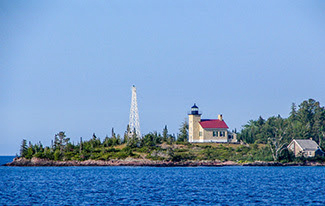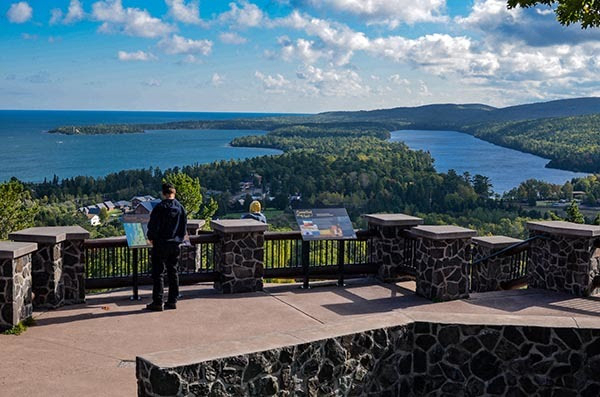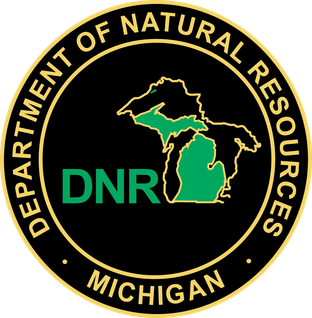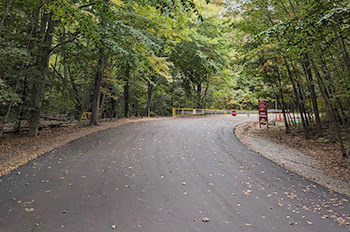Michigan: restoration continues at Copper Harbor Lighthouse in Keweenaw County


Standing as a silent guard at the very top of the Upper Peninsula, the Copper Harbor Lighthouse once guided vessels traveling in Lake Superior to safe harbor.
Originally built in 1848, the lighthouse site consisted of a 44-foot stone tower with a lantern room, a detached lightkeeper’s dwelling and landing dock.
By the 1860s, the Keweenaw Peninsula’s harsh winters and Lake Superior’s severe weather had taken their toll on the original buildings. The U.S. Lighthouse Service replaced the stone structures with a brick lighthouse and attached living quarters.
Beginning in 1866, the new lighthouse was manned by lightkeepers and their families until it was automated in 1919. By 1958, the lighthouse had become obsolete, and the U.S Coast Guard sold the property to the Michigan Department of Natural Resources.
Today the lighthouse site, which is part of Fort Wilkins Historic State Park, includes the original 1848 keeper’s quarters and the 1866 lighthouse. While time may have changed the lighthouse’s purpose, the need to protect the historic buildings from the elements is still pressing.
Michigan’s historic state parks offer visitors the unique experience to view, enjoy and learn about site histories and their significant structures. As stewards of these places, the DNR is responsible not only for telling their stories, but also for their preservation and maintenance.
This can be a challenging task when working on buildings that are almost 200 years old, as was the case at the Copper Harbor Lighthouse in the summer of 2019. The lighthouse is comanaged by the DNR’s Michigan History Center and Parks and Recreation Division.
“For several years we had been monitoring brick and mortar issues within the fort and a brick spalling issue at the Copper Harbor Lighthouse,” said Fort Wilkins Historic State Park manager Bob Wild.
| Brick spalling is when the surface of a brick flakes off.
“In addition to the lighthouse, the 1848 lighthouse keeper’s dwelling had some structural issues. It is the original keeper’s dwelling – arguably the oldest lighthouse related structure on Lake Superior,” Wild said. Some of the maintenance and preservation issues are a result of past missteps in caring for the building. In order to remove decades of paint from the 1866 lighthouse’s surface in the late 1960s, park staff sand-blasted the lighthouse’s exterior. Unfortunately, the work also removed the original brick finish, which eventually allowed water to leach into the brickwork. Over time, the natural freezing and thawing cycle caused pieces of brick to break, or “pop,” off the building. Fixing this problem was not simple. The Copper Harbor Lighthouse is listed on the National Register of Historic Places, and historic buildings require extra care and attention. |
| In accordance with Michigan’s State Historic Preservation Office, all materials must meet the Secretary of the Interior’s Standards for the Treatment of Historic Properties. With buildings, this includes working with original materials, including brick, mortar and paint colors.
Due to the scope of the project, which included repairs to the old keeper’s house foundation and walls, it was decided to bid out the project to a professional restoration firm. Restoration work began on the Copper Harbor Lighthouse and 1848 keeper’s residence in September 2019 and lasted eight weeks. National Restoration Inc., of Milford, which has worked on several Michigan lighthouses, including Fort Gratiot and the Old Mackinac Point lighthouses, was the contractor that completed the work with the DNR. “Approximately 1,000 bricks were replaced. In order to ensure historical accuracy, the replacement bricks included reclaimed light orange/pink Chicago Common bricks sourced from the Colonial Brick Company in Chicago and replica light yellow/milk cream Milwaukee Cream bricks sourced separately,” said Eric Cadeau, regional field planner for the DNR Parks and Recreation Division. |
| Regarding the lightkeeper’s residence, Cadeau noted the mortar had experienced extensive weathering on its windward sides.
“National Restoration performed deep repointing and stone masonry rebuilding of exterior walls. The repairs utilized local rock and local beach sand to ensure consistency with the historic materials,” he said. Funding for the project came from DNR Recreation Passport Cultural Resource Stewardship and DNR Park Improvement/Park Endowment funds. “We are pleased with the work that was completed,” Wild said. “With the repairs both structures should last another 150 years.” With ongoing preservation, conservation and restoration efforts, the Copper Harbor Lighthouse buildings will continue as well-preserved examples of mid-19th-century lighthouse life on the northern frontier. |
| The Copper Harbor Lighthouse is part of Fort Wilkins Historic State Park and is accessible only by water. The lighthouse and keeper’s dwelling will not be open to the public this summer due to the ongoing public health emergency.
Some fun facts about Michigan lighthouses and the Copper Harbor area:
For more information on Fort Wilkins Historic State Park and other historic Michigan parks, visit Michigan.gov/StateParks. |
Check out previous Showcasing the DNR stories in our archive at Michigan.gov/DNRStories. To subscribe to upcoming Showcasing articles, sign up for free email delivery at Michigan.gov/DNR.
By BARRY C. JAMES
Michigan Department of Natural Resources





